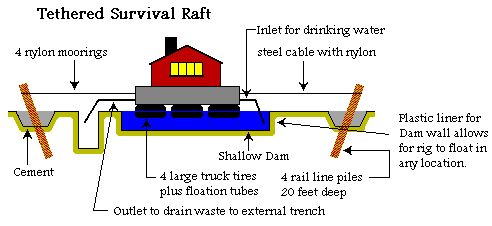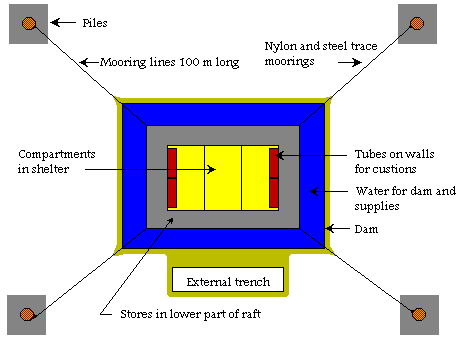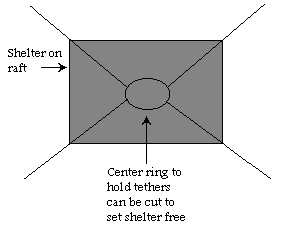
 Water Cushion
Water Cushion
I have been trying to visualize a way to survive mega quakes. So far:

- I am thinking of a relatively shallow dam with a raft with a dwelling made from numerous
truck tubes. The raft could be set in a small shallow dam, dug and filled for this purpose. The dam water
to be only knee deep so one could walk to and from shelter. In any case the dammed water would be a
useful asset. This would also absorb any smaller jolts, and would be constant proof and reassurance that
the buoyancy was OK. The dam need only be slightly bigger than the raft to do this job. Thus someone
one a farm with a couple of dozen tires would have all that was needed.

- The raft is secured by four deep steel piles via nylon "mooring" lines, say 100 meters long to
all cardinal points. Nylon has great strength and some stretch and a steel wire trace could be placed at the
near max stretch of nylon mooring lines to back them up. This would cover both lateral and vertical
earthquakes. I would bring the four steel traces to a center ring and to that attach personal safety lines as
yacht sailors use. Care on getting the steel piles deep and cemented most important.

- While a survival trench certainly will give more wind and fire type protection it will be a hell
place to be in a huge jolt ( before, during and after ). The Chinese build huge sailing junks
without an unstayed mast, in a Typhoon the mast gives and the vessel survives. In a tethered raft
the shocks will be absorbed much the same, it could still have a heavy duty steel cover, and does
not have the worry of getting out of a buried trench, and always getting air in. I would not like to
rely on a dugout if there was also a chance of inundation's, so the floating "capsule" is double
survival chance.
- The most likely worst effect would be to get a shower from splashing water occasionally. A
heavy pair of bolt cutters and a knife would allow one to cut the tethers if the water level went up
beyond the allowed lift in the tethers. Should the inundation cause the raft to rise on the four
moorings, the center tether should be cut freeing 3 moorings, and not setting the raft free just yet.
The fourth mooring would hold the raft as an anchor point and allow for even further rises yet
remain tethered. If flooding continued even higher then cut the fourth tether and take your
chance on a wild ride to who knows where, but still a very high survival possibility. The worlds
history and literature has many stories of people surviving clinging to various rafts, etc.
- More smaller car tubes could be put on the inner walls as cushion shock absorbers for further
back up. If the dam became exhausted the system would still work, this time with truck tires say at the
four extremes of the raft acting as skids and shock absorbers. If all this was on a clay type base abrasion
of tires with lateral movement would be minimal.
- The shelter could have a tent like cover. An additional benefit of floating on a dam would be
immediate access to water in a fire storm. For drinking water, simple water boiling and carbon filtration
would provide perfectly suitable water, if the water was cloudy, some alum sulfate to flocculate (cause the
particles to drop out of suspension ) could be added prior to boiling. Provided waste water was sent to a
separate trench and the dam could easily be lined with a plastic liner for low cost, then there would be no
contamination.
- The whole thing would be easy to build and cheap. Most tire repair places are happy to give
away old tires and even quite repairable tubes. The truck tires would either have tubes inflated or better
still be foam filled with two anchor plates to hold and protect the foam there (much as is done to make
mooring buoys).
Anyway, we have to start thinking about concepts that might just work. Might not be the Hilton but it
would give a fighting chance.
Design by Darryl



![]()


